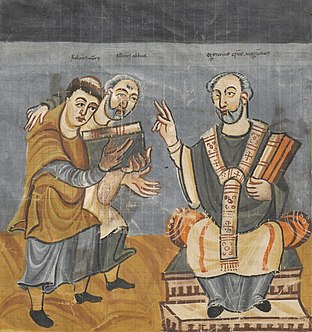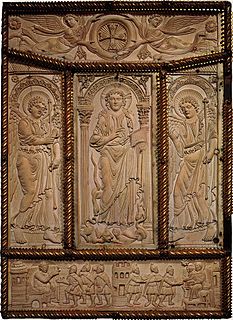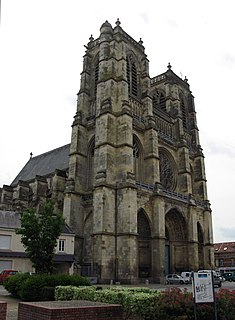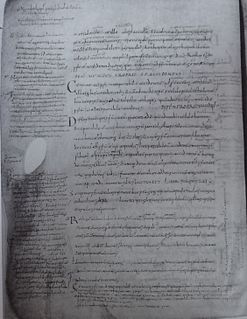Related Research Articles

Alcuin of York – also called Ealhwine, Alhwin, or Alchoin – was an English scholar, clergyman, poet, and teacher from York, Northumbria. He was born around 735 and became the student of Archbishop Ecgbert at York. At the invitation of Charlemagne, he became a leading scholar and teacher at the Carolingian court, where he remained a figure in the 780s and 790s. "The most learned man anywhere to be found", according to Einhard's Life of Charlemagne, he is considered among the most important intellectual architects of the Carolingian Renaissance. Among his pupils were many of the dominant intellectuals of the Carolingian era.

The Carolingian Renaissance was the first of three medieval renaissances, a period of cultural activity in the Carolingian Empire. It occurred from the late 8th century to the 9th century, taking inspiration from the Christian Roman Empire of the fourth century. During this period, there was an increase of literature, writing, the arts, architecture, jurisprudence, liturgical reforms, and scriptural studies.

Carolingian minuscule or Caroline minuscule is a script which developed as a calligraphic standard in Europe so that the Latin alphabet of Jerome's Vulgate Bible could be easily recognized by the literate class from one region to another. It is thought to have originated before AD 778 at the scriptorium of the Benedictine monks of Corbie Abbey, and then developed by Alcuin of York for wide use in the Carolingian Renaissance. However, the script Alcuin wrote was still not the Carolingian minuscule, which slowly developed over three centuries. He was most likely responsible for copying and preserving the manuscripts and upkeep of the script. It was used in the Holy Roman Empire between approximately 800 and 1200. Codices, pagan and Christian texts, and educational material were written in Carolingian minuscule.
Nithard, a Frankish historian, was the son of Charlemagne's daughter Bertha. His father was Angilbert.
Rosamond Deborah McKitterick is an English medieval historian. She is an authority on the Frankish kingdoms in the eighth and ninth centuries AD, who uses palaeographical and manuscript studies to illuminate aspects of the political, cultural, intellectual, religious, and social history of the Early Middle Ages. From 1999 until 2016 she was Professor of Medieval History and Director of Research at the University of Cambridge. She is a Fellow of Sidney Sussex College and Professor Emerita of Medieval History in the University of Cambridge.
Pseudo-Isidore is the conventional name for the unknown Carolingian-era author behind an extensive corpus of influential forgeries. Pseudo-Isidore's main object was to provide accused bishops with an array of legal protections amounting to de facto immunity from trial and conviction; to secure episcopal autonomy within the diocese; and to defend the integrity of church property. The forgeries accomplished this goal, in part, by aiming to expand the legal jurisdiction of the Bishop of Rome.
Saint Adalard of Corbie was son of Bernard the son of Charles Martel and half-brother of Pepin; Charlemagne was his cousin.
Merovingian script or Gallo-Roman script was a medieval variant of the Latin script so called because it was developed in Gaul during the Merovingian dynasty. It was used in the 7th and 8th centuries before the Carolingian dynasty and the development of Carolingian minuscule.
The Royal Frankish Annals are Latin annals composed in Carolingian Francia, recording year-by-year the state of the monarchy from 741 to 829. Their authorship is unknown, though Wilhelm von Giesebrecht suggested that Arno of Salzburg was the author of an early section of the Annales Laurissenses majores surviving in the copy at Lorsch Abbey. The Annals are believed to have been composed in successive sections by different authors, and then compiled.

Carolingian art comes from the Frankish Empire in the period of roughly 120 years from about 780 to 900—during the reign of Charlemagne and his immediate heirs—popularly known as the Carolingian Renaissance. The art was produced by and for the court circle and a group of important monasteries under Imperial patronage; survivals from outside this charmed circle show a considerable drop in quality of workmanship and sophistication of design. The art was produced in several centres in what are now France, Germany, Austria, northern Italy and the Low Countries, and received considerable influence, via continental mission centres, from the Insular art of the British Isles, as well as a number of Byzantine artists who appear to have been resident in Carolingian centres.

Corbie Abbey is a former Benedictine monastery in Corbie, Picardy, France, dedicated to Saint Peter. It was founded by Balthild, the widow of Clovis II, who had monks sent from Luxeuil. The Abbey of Corbie became celebrated both for its library and the scriptorium.

Dhuoda was a Frankish writer, as well as Duchess consort of Septimania and Countess consort of Barcelona. She was the author of the Liber Manualis, a handbook written for her son.
Joseph or Josephus Scottus, called the Deacon, was an Irish scholar, diplomat, poet, and ecclesiastic, a figure in the Carolingian Renaissance. He has been cited as an early example of "the scholar in public life".
Christian views on the classics have varied widely throughout history.
The Admonitio generalis is a collection of legislation known as a capitulary issued by Charlemagne in 789, which covers educational and ecclesiastical reform within the Frankish kingdom. Capitularies were used in the Frankish kingdom during the Carolingian dynasty by government and administration bodies and covered a variety of topics, sorted into chapters. Admonitio generalis is actually just one of many Charlemagne's capitularies that outlined his desire for a well-governed, disciplined Christian Frankish kingdom. The reforms issued in these capitularies by Charlemagne during the late 8th century reflect the cultural revival known as the Carolingian Renaissance.
The Epistola de litteris colendis is a well-known letter addressed by Emperor Charlemagne to Abbot Baugulf of Fulda, probably written sometimes in late 780s to 800s (decade), although the exact date is still debatable. The letter is a very important witness to the Carolingian educational reforms during the Carolingian Renaissance from late 8th century to 9th century. The letter shows Emperor Charlemagne's interest in promoting learning and education within his empire.
The medieval renaissances were periods characterised by significant cultural renewal across medieval Western Europe. These are effectively seen as occurring in three phases - the Carolingian Renaissance, Ottonian Renaissance and the Renaissance of the 12th century.

The Excarpsus Cummeani, also called the Pseudo-Cummeani, is an eighth-century penitential, probably written in the north of the Frankish Empire in Corbie Abbey. Twenty-six copies of the manuscript survive; six of those were copied before 800 CE. It is possible that the penitential, which extends its scope beyond monasticism to include clerics and lay people, has a connection to Saint Boniface and his efforts to reform the Frankish church in the first half of the eighth century. Geographic spread by the end of the eighth century and continued copying of the manuscript into the 9th and 10th centuries have been interpreted to mean the work was considered "by the Christian authorities" a canonical text. It was used as late as the eleventh century, "as the main source of the P. Parisiense compositum".

The so-called Aachen Compilation of 809–812, also called the Handbook of 809 is a Carolingian astronomical compendium, compiled by a group of astronomers who gathered at the court of Charlemagne at Aachen in the year 809.

Israel the Grammarian was one of the leading European scholars of the mid-tenth century. In the 930s, he was at the court of King Æthelstan of England (r. 924–39). After Æthelstan's death, Israel successfully sought the patronage of Archbishop Rotbert of Trier and became tutor to Bruno, later the Archbishop of Cologne. In the late 940s Israel is recorded as a bishop, and at the end of his life he was a monk at the Benedictine monastery of Saint-Maximin in Trier.
References
- ↑ Franck Cinato, "Le ‘Goth Ansileubus’, les Glossae Salomonis et les glossaires wisigothiques: Mise aupoint sur les attributions et les sources glossographiques du Liber glossarum", Dossiers d'HEL8 (2015): 37–56. This name appeared in the 17th century based on a misunderstanding. Ansileubus, describes as a Gothic bishop, was probably the owner of a manuscript (now lost) once at Moissac.
- ↑ Bischoff, Bernard. Latin Paleography. Translated by Daibhi o Croinin and David Ganz. Cambridge: Cambridge University Press. Pg. 106
- ↑ W. M. Lindsay (1917), "The Abstrvsa Glossary and the Liber Glossarvm", The Classical Quarterly, 11 (3): 119–131, doi:10.1017/s0009838800011010 .
- ↑ McKitterick, Rosamond. The Frankish Kingdoms Under the Carolingians, 751-987. London: Longman, 1983. Pp. 140-168.
- ↑ Huglo, Michel. "Les Arts Liberaux Dans Le ‘Liber Glossarum’" in Scriptorium. 2001. No. 1. Pg. 3-33.
- ↑ Goetz, Georg. Der Liber Glossarum. Leipzig: S. Hirzel, 1891.
- ↑ Liber Glossarum. Single leaf of a Carolingian glossary, ca. 825